As Millennials and Generation Z fill up the talent pool, job satisfaction is becoming an increasingly important factor.
The 2020 pandemic further catalyzed the growing importance of worker satisfaction. This further added fuel to the Great Resignation, which is still an ongoing economic trend.
In fact, according to the Bureau of Labor Statistics, almost 47 million U.S. workers quit their jobs in 2021.
We gathered 10 job satisfaction statistics to help to put this into perspective.
1. 72% of U.S. workers are happy with their job (Source)
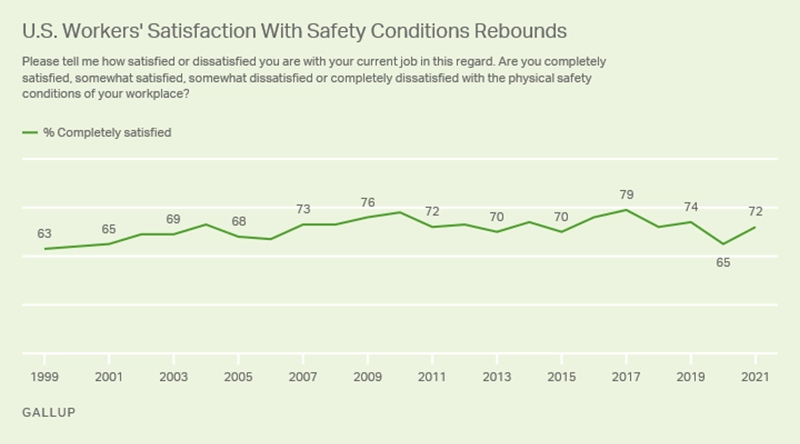
According to a poll by Gallup, 72% of U.S. workers are satisfied and happy with their current jobs. That number was at 65% in 2020, the lowest since 2001, which also had a 65% employee satisfaction rate.
Overall job satisfaction levels were the highest in 2017 at 79%. It decreased by 5% by 2019; however, the major dip to 65% in 2020 was mainly due to the COVID-19 pandemic.
The same Gallup poll also found that in 2021, 56% of American workers favored organizations that required team members to show proof of vaccination at their physical office.
Furthermore, the study dove into the difference in job satisfaction based on different factors:
- Out of all U.S. workers, 70% of men were happy employees while 75% of women said they were happy with their jobs.
- 74% of white workers were happy with their jobs while the percentage of non-white workers who were happy with their jobs was 68%.
- 73% of people with a college degree were satisfied with their jobs while 72% of people without a college degree were satisfied with their jobs.
- 67% of people with an annual household income below $75,000 were happy with their jobs while 76% of people who had an annual household income greater than $75,000 were satisfied with their jobs.
Between 2020 and 2021, almost every category saw an improvement in job satisfaction rates.
2. Only 13% of U.S. workers are passionate about their jobs (Source)
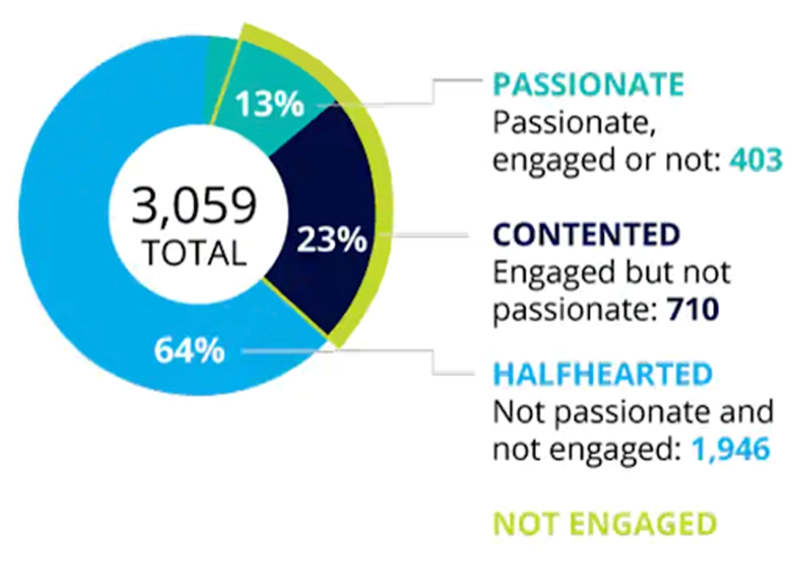
According to a Deloitte survey of more than 3,000 full-time U.S. employees, only 13% of respondents were passionate about their job. A larger percentage, 23%, were categorized as “contented,” and an overwhelming majority of 64% were classified as “halfhearted” or not engaged.
Employees classified as “passionate” possessed three attributes of worker passion:
- Seeking out challenging tasks.
- Connecting with others to find the best solution.
- Desiring to make a significant contribution.
Contented workers were those who possessed high engagement but didn’t have all three elements of worker passion. Halfhearted employees lacked all three attributes and had low engagement.
Various workplace triggers and poor well-being can have a negative effect on employee retention, attendance, and even performance.
This 2021 study found that workers felt they performed at less than 75% of their actual capacity. Plus, almost half of employees had left a job due to mental health reasons. Among Gen Z and Millennials, this number shot up to 81% and 68% respectively.
Along with this trend, 32% more organizations started to cite mental health as an organizational priority in 2021 compared to 2020.
Workers being passionate about their jobs is directly tied to employee well-being and mental health. Therefore, organizations are focusing on mental health as a priority, especially with the growing trend of remote work.
3. 65% of U.S. workers are actively looking for a new job (Source)
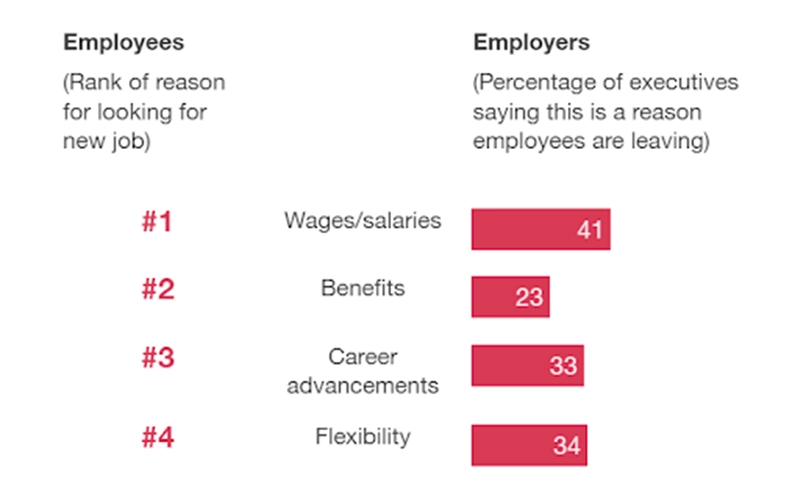
According to PWC’s 2021 U.S. Pulse Survey, 65% of American employees are looking for new jobs while being employed. Most people are looking for new models of work.
The survey also talked to organization executives, 88% of whom shared that they’re facing a higher employee turnover than normal.
Companies understand the reason employees are looking for new jobs. Here’s a breakdown of the four main reasons:
- 41% of people cited wages as their number one reason.
- 34% cited flexibility.
- 33% of people said career advancement opportunities.
- 23% of survey respondents cited benefits.
However, 48% of companies are focusing on changing processes so they’re less dependent on their employees’ institutional knowledge in a bid to tackle turnover workflow loss.
Meanwhile, when it comes to remote or hybrid work, 36% of executives believe hybrid work may lead to a loss of corporate culture. That’s why only 18% of companies have plans to go fully hybrid and 4% have plans to go completely remote.
That said, 33% of organizations believe in a balance of in-person, hybrid, and remote work.
4. 36% of U.S. workers are satisfied with their workload, 39% are neutral, and 24% are unhappy with their amount of work (Source)
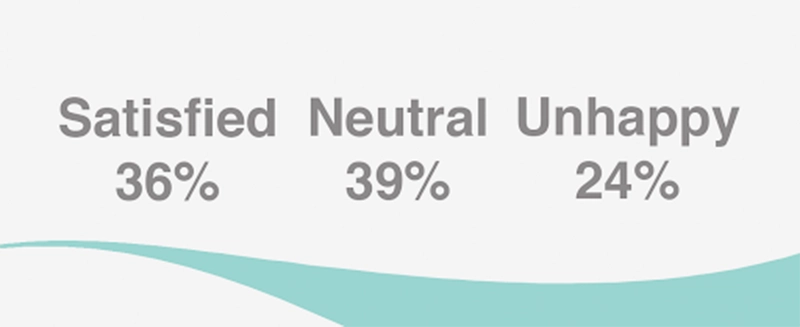
Based on the nearly 165 million people in the U.S. workforce in 2020, roughly 60 million people are satisfied with their workload. Meanwhile, roughly 65 million are neutral and 40 million are unhappy with their workload.
Worker satisfaction data also revealed that of 15,000 respondents:
- 39% were unhappy with their rewards and compensation.
- 33% were neutral.
- 26% were happy with their compensation.
When it came to career growth:
- 36% of respondents were satisfied with their career trajectories.
- 33% were neutral.
- 29% experience job dissatisfaction.
Regarding the help and support employees get from upper management and executives:
- 58% of employees revealed they are happy.
- 26% were neutral.
- 14% were unhappy.
When it came to the meaningfulness of their work:
- 47% felt happy about it.
- 35% were unsure.
- 17% were unhappy employees.
5. 40% of employees are considering leaving their jobs within the next three to six months (Source)
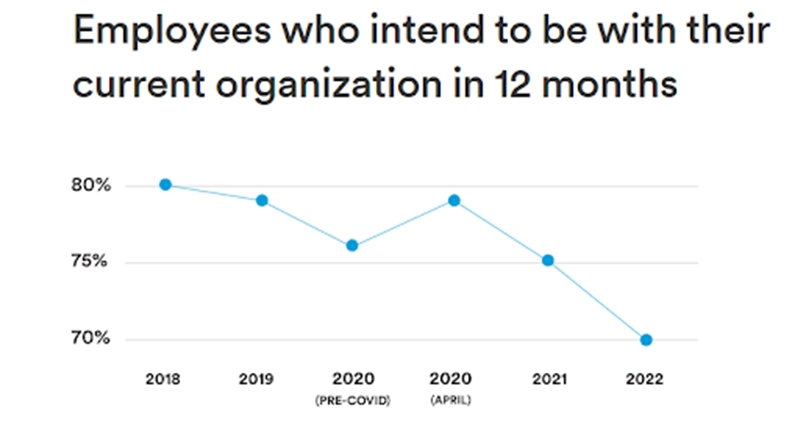
According to a 2021 report by McKinsey, over 19 million U.S. workers quit their jobs between April 2021 and December 2021.
However, their latest report found that workers are switching jobs and industries to get unique roles, start their own businesses, or retire early.
Workers are also looking beyond traditional positions, pay, and perks. In a study of 13,000 respondents, employees cited low autonomy, unfair treatment, unreasonable workload, lack of social support, and always being on call as their reason for exiting.
Employees are looking for more meaningful work, additional flexibility, and more mental health support from organizations.
McKinsey breaks employee profiles into traditionalists, do-it-yourselfers, and idealists. While companies continue to look for traditionalists, more and more people are moving away from that persona.
6. Healthy employees are 74% more likely to be satisfied with their job (Source)
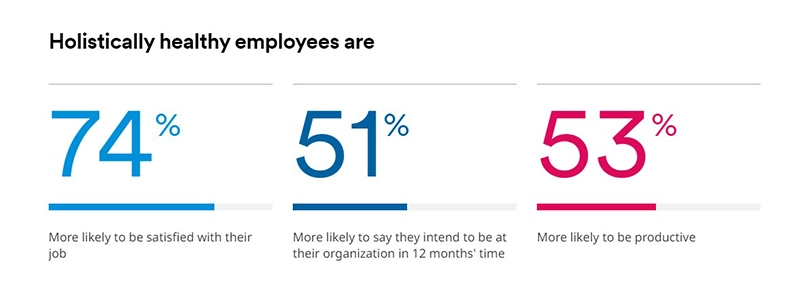
The Metlife report also found that healthy employees are 51% more likely to remain employed at their current job in 12 months. They are also 53% more likely to have high employee productivity in the workplace.
While the combined health of employees is improving, less than half of the employees surveyed reported that they’re completely healthy in every aspect. An employee’s holistic health is divided into four categories:
- Mental health – 68% of employees felt mentally healthy in 2022, a decline from 73% in April 2020.
- Physical health – 69% of employees felt physically healthy, an improvement from 66% in 2021.
- Social health – 67% of employees felt socially healthy, an improvement from 64% in 2021.
- Financial health – 64% of employees felt financially healthy, an improvement from 61% in 2021.
Meanwhile, employees’ holistic health was at 45%, a decent improvement from 41% in 2021.
More employers are concerned about their employees’ well-being. The report found that 72% of employers are concerned that employee burnout and stress are major challenges for their company.
This is why organizations are focusing on five key areas that matter the most when it comes to job satisfaction:
- Purposeful work is 200% more likely to make employees stay.
- Social and supportive workplace cultures increase the likelihood of employees staying by 150%.
- A healthy work-life balance and flexibility make employees 180% more likely to stay.
- Wellness programs and benefits increase employee retention by 160%.
- Companies with career training and development opportunities have a 170% chance of making employees stay.
The key is to have the right mix of benefits for your employees.
7. 57% of employees that work from home are satisfied with their job (Source)
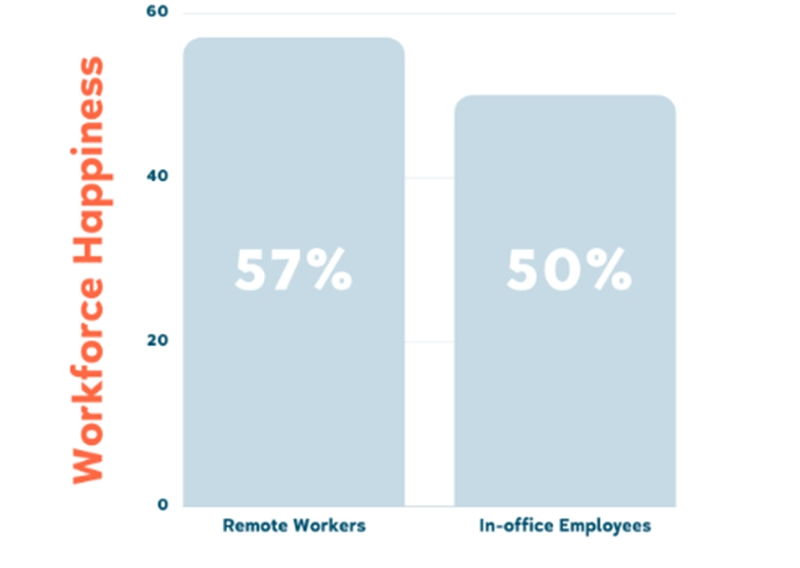
The same survey found that 50% of people working in-house were satisfied with their job. Remote workers have a Workforce Happiness Index score of 75 out of 100, and in-house workers have a score of 71 out of 100.
Here’s how perceptions of pay, advancement opportunities, and feeling valued varied between remote and traditional employees:
- 81% of remote workers consider themselves well-paid, while 75% of in-house employees consider themselves well-paid.
- 66% of remote employees say their organization provides them with excellent career advancement opportunities while 58% of in-house employees share the same sentiment.
- 54% of remote workers consider their work to be valued by their fellow colleagues while only 48% of in-house employees believe that.
In 2021, the Workforce Happiness Index was 72 out of 100. However, employees who believed their companies were doing enough for diversity, equity, and inclusion had a score of 75 while employees at companies who believed their companies weren’t doing enough had a score of 63.
Here are some things the CNBC and SurveyMonkey study discovered about worker attitudes toward remote vs. onsite work:
- 27% of workers prefer working with others onsite.
- 52% believe onsite workers have better career opportunities.
- 40% of workers believe they’ll be working from their offices again.
- 19% believe they’ll be working from home indefinitely.
A 2022 survey from CNBC and Momentive tracked the current breakdown of remote vs. onsite work. Here’s what it found:
- 65% of workers are now working from offices.
- 4% are primarily working in-person.
- 9% are mostly remote.
- 11% are completely remote.
Meanwhile, the overall happiness index was 71 out of 100.
8. Companies with higher job satisfaction outperform low-satisfaction companies by 202% (Source)
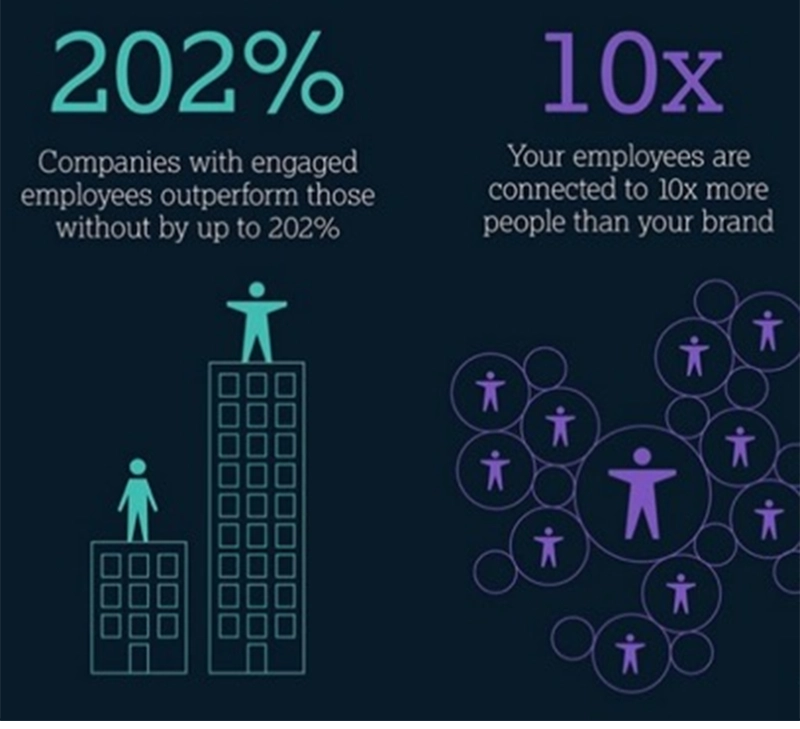
Gallup’s massive employee engagement survey found that the average level of engagement among employees worldwide is 20%. Meanwhile, the average employee engagement in the U.S. is 30%.
Organizations with more engaged employees outperformed companies without an engaged workforce by 147% in earnings per share.
The survey found organizational employees are 10 times more connected to people than the brand itself.
Almost every employer today considers retention a critical priority and is focused on providing employee experience improvements and flexible work options.
In fact, economists believe that in the past decade alone, there has been a 50% increase in companies providing alternative work arrangements. Meanwhile, McKinsey reported that between 20-30% of the U.S. and European workforce believes in alternative work engagements and utilize the gig economy.
The continuous change in working environments over the past decade has led to rippling changes. It’s one of the reasons why job seekers shouldn’t add work experience older than 15 years to their resume. It’s more important to focus on recent work and how they’ve managed around it.
In any case, this rising focus on alternative work arrangements has proven to be a challenge for organizations wishing to engage their remote workers.
Experts advise companies to utilize a Net Promoter Score survey to determine where their remote employees stand. Regular surveys help determine how employees feel, what they need, and how organizations can help them feel more engaged.
9. 52% of Millennials are satisfied with the diversity and inclusivity of their work environment and are willing to stay beyond 5 years (Source)

Diversity, the environment, and social causes matter to Millennial employees, and it has a significant effect on employee turnover.
Only 11% of surveyed employees who are dissatisfied with the diversity and inclusivity of their work environment are willing to stay more than five years at the company.
Of employees who wish to leave their organization within two years, 17% are satisfied with the diversity and inclusivity of the working environment and 52% are dissatisfied.

When it comes to the societal impact of their company, 53% of Millennials willing to stay beyond five years are satisfied with their company, while only 13% of those who are dissatisfied are willing to stay that long.
Of employees who are looking to leave in the next two years, 51% are dissatisfied with their company’s societal impact. Only 17% of employees who are satisfied are looking to leave within two years.

Regarding the company’s commitment to sustainability, 51% of employees are very satisfied and willing to stay for more than five years, while only 17% of employees who are satisfied are looking to leave in the next two years.
48% of employees who are dissatisfied with their company’s commitment to sustainability plan to leave within two years, while only 17% of those who are satisfied plan to leave that soon.
10. 75% of employees in the U.S. believe that company culture drives their active engagement at work, improving job satisfaction (Source)
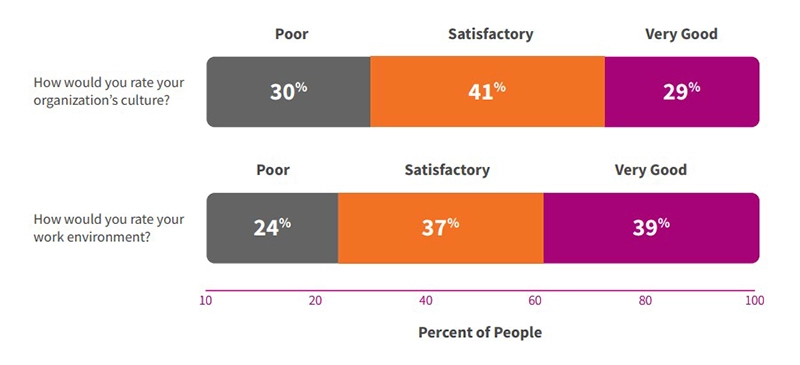
According to Deloitte, 94% of executives believe a strong organizational culture is extremely important for business success.
Despite that, only one-third of organizations manage to find a good balance between company culture and engagement. A report by Tinypulse found that 29% of employees believed their company had a “very good” culture, 41% considered it “satisfactory,” and 30% rated it “poor.”
Regarding the work environment, 39% of employees rated it “very good,” while 37% considered it “satisfactory” and 24% rated it “poor.”







